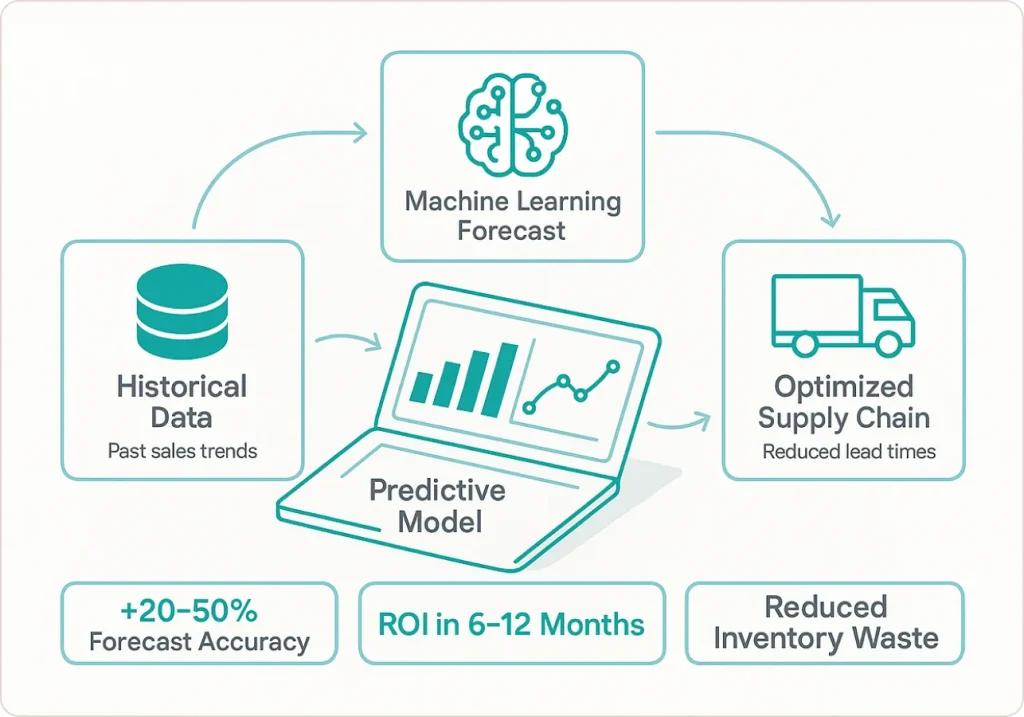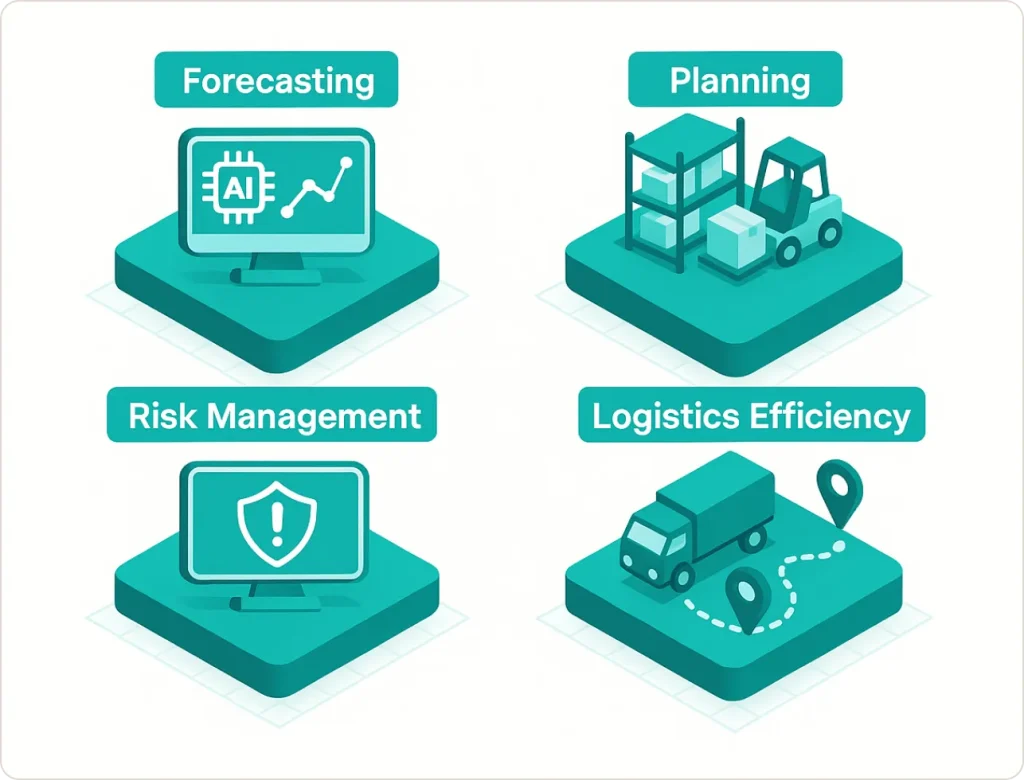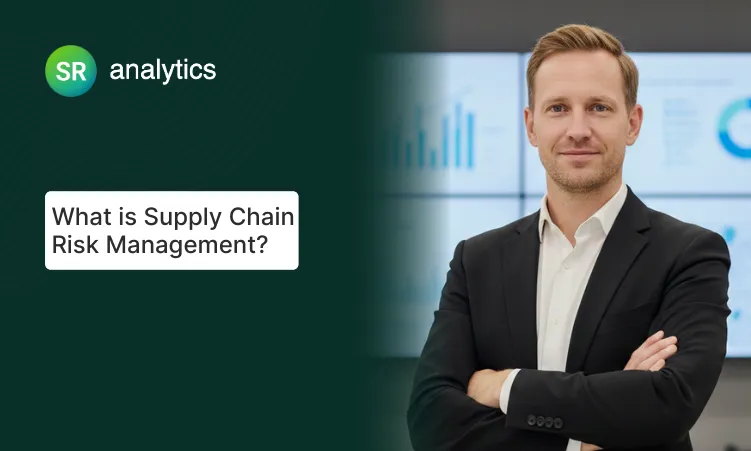Key Highlights:
- AI-based forecasting reduces errors by 20-50% compared to traditional spreadsheet methods, according to McKinsey research
- 77% of logistics partners now invest in predictive analytics to stay competitive (2024 CSCMP State of Logistics report)
- Implementation delivers ROI in 6-12 months through reduced stockouts, optimized inventory carrying costs, and fewer expedited shipments
- Mid-market companies achieve results without massive budgets (pilots start at $25K-$75K with proven frameworks)
Your largest supplier just declared force majeure. Your backup can’t scale production for six weeks. You’re about to blow Q4 commitments worth $2.3M, and you had zero warning until the email hit your inbox this morning.
This exact scenario happens 40+ times daily across U.S. manufacturing and distribution, and 73% of supply chain leaders admit they’re still reacting to disruptions instead of preventing them. The cost? Research shows that organizations without predictive capabilities lose 7-12% of annual revenue to avoidable supply chain problems.
After implementing predictive analytics across 51+ supply chain operations over the past decade, I’ve watched the pattern repeat: organizations that adopt data-driven forecasting cut operating costs by 15-25% within the first year while simultaneously improving on-time delivery and customer satisfaction. The technology isn’t mysterious, the investment isn’t prohibitive, and the results are measurable within quarters, not years.
Quick Answer:
Supply chain predictive analytics uses historical data and machine learning to forecast demand, prevent disruptions, and optimize inventory before problems occur, delivering 20-50% forecast accuracy improvements and measurable ROI within 6-12 months.

What Is Supply Chain Predictive Analytics?
Supply chain predictive analytics combines historical data, real-time inputs, and machine learning algorithms to forecast future supply chain events before they impact your operations. Instead of reacting to stockouts, supplier delays, or demand spikes after they occur, you see problems coming weeks in advance and adjust inventory, production, and logistics proactively.
Think of the difference between driving with GPS that shows traffic ahead versus just seeing brake lights in front of you. Traditional analytics tells you what already happened (last month’s sales, yesterday’s shipments). Predictive analytics shows you what’s likely to happen next week, next month, next quarter, giving you time to respond strategically rather than reactively.
Modern predictive systems analyze multiple data streams simultaneously: historical patterns from your ERP showing seasonal trends and promotional impacts, real-time signals from IoT sensors and point-of-sale systems providing current conditions, and external factors including weather forecasts, economic indicators, and supplier financial health scores.
Statistical algorithms and machine learning models process these inputs to generate probabilistic forecasts. The key advantage: these models improve automatically as they ingest more data, unlike static Excel formulas requiring manual updates. Comprehensive supply chain analytics solutions integrate these predictive capabilities with your existing systems to deliver actionable insights across operations.
How Predictive Differs From Other Analytics
- Descriptive analytics answers “what happened?” It’s your dashboard showing last quarter’s sales or this month’s inventory turns (essential for reporting, but backward-looking).
- Diagnostic analytics answers “why did it happen?” Root cause analysis that explains sales drops or delivery delays (helps you understand problems but doesn’t prevent future ones).
- Predictive analytics answers “what will happen?” Forecasts future demand, identifies likely disruptions, calculates probability of supplier delays (this is where proactive management begins).
- Prescriptive analytics answers “what should we do about it?” Recommends specific actions like optimal order quantities or best routing decisions (the most sophisticated approach combining prediction with optimization).
Why Supply Chain Predictive Analytics Matters Now
The supply chain leaders I worked with in 2015 managed operations using planning approaches from 1995: Excel-based forecasts built on historical averages, manual supplier reviews, static safety stock formulas. It worked fine when patterns were stable and lead times predictable.
Then volatility became the baseline. A 2024 Gartner study found that 68% of supply chain organizations experienced “severe or moderate disruption” in the past year, and most never saw it coming. Demand patterns that used to shift quarterly now change weekly. The old rule of thumb (“use last year’s numbers adjusted 5% for growth”) fails when last year’s patterns don’t repeat.
Margins can’t absorb inefficiency. When you’re operating on 8-12% margins, the cost of expedited freight, obsolete inventory, or lost sales from stockouts directly threatens profitability. Organizations using supply chain analytics solutions reduce inventory carrying costs by 15-25% while improving service levels (a combination impossible through traditional approaches).
Customer expectations compressed. Next-day delivery used to be a premium service. Now it’s baseline. When customers expect products available immediately, a three-day forecast error means lost sales you can’t recover. Amazon doesn’t dominate retail logistics through better guessing. They predict demand at the ZIP code level and position inventory before customers click “buy.”
Key Benefits of Predictive Analytics in Supply Chain Operations

More Accurate Demand Forecasting
Traditional forecasting relies on historical averages. Predictive models incorporate 20-40 variables simultaneously: promotional calendars, competitor pricing, weather patterns, search trends, and real-time sales velocity.
McKinsey research documents that AI-based forecasting reduces errors by 20-50% compared to traditional methods. I worked with a regional beverage distributor who improved forecast accuracy from 68% to 89% by incorporating weather predictions and local event calendars. The result: 32% fewer stockouts during peak summer weeks and 18% less obsolete inventory.
For a CPG client, we built models that detected early demand signals from online search behavior. When search volume for a product category increased 15% week-over-week, the model flagged potential demand acceleration three weeks before it appeared in retailer orders. That lead time prevented stockouts worth $400K+ in lost revenue.
Optimized Inventory and Supply Planning
Better forecasts enable smarter inventory decisions. Instead of choosing between expensive safety stock everywhere or frequent stockouts, supply chain analytics solutions find the optimal balance based on actual demand variability.
I’ve seen manufacturers reduce inventory carrying costs by 15-28% while simultaneously improving service levels from the low 80s to mid-90s percentage-wise. One electronics distributor reduced total inventory investment by $2.1M (22% reduction) while improving fill rates from 84% to 93%. The secret: predictive allocation, positioning inventory where demand was predicted to occur rather than where it historically happened. Learn more about demand forecasting solutions that deliver these results.
Proactive Risk Management
Modern systems monitor dozens of risk factors: supplier on-time delivery trends, quality metrics, financial health indicators, port congestion levels, and news feeds. When multiple indicators suggest elevated risk, the system flags potential problems with enough lead time to qualify alternate sources.
A Midwest automotive supplier avoided a three-week production shutdown by acting on early warnings. Their predictive model detected a critical supplier showing declining on-time delivery combined with increasing quality rejections. The system recommended qualifying a backup source. Two weeks later, the primary supplier experienced a walkout. Because my client had already ramped an alternate, they maintained production while competitors scrambled.
According to the 2024 CSCMP State of Logistics report, 77% of logistics partners now invest in predictive analytics specifically for risk visibility. The cost of disruption far exceeds the investment in prevention.
Improved Logistics Efficiency
Predictive logistics considers real-time traffic patterns, weather conditions, and carrier performance to recommend routes that minimize cost while maximizing on-time delivery probability.
UPS’s ORION platform uses predictive analytics to dynamically adjust 55,000 routes daily, saving over $400M annually through reduced miles and optimized fuel consumption. For mid-market clients, similar approaches typically reduce freight costs by 8-15% and improve on-time delivery from the low-to-mid 80s into the mid-90s percentage range.
By reducing empty miles (which account for 35% of truck miles driven in the U.S.), companies simultaneously cut costs and carbon emissions, addressing both financial and ESG goals.
Real-World Applications: Where to Start
Walmart’s Demand Forecasting Approach
Your content about Walmart using “massive datasets (historical sales, demographics, weather, search trends) to forecast demand at the store-SKU level” is accurate and supported by multiple sources. Walmart does integrate external data like weather patterns, local events, demographics, and seasonal trends into their AI-powered forecasting systems. (Source)
Amazon’s Anticipatory Shipping
The concept of Amazon’s “anticipatory shipping” using predictive analytics to position inventory near customers before orders are placed is confirmed. This is a patented system that Amazon filed for and uses to pre-position products in warehouses or local delivery hubs based on predictive analytics. (Source)
Predictive Maintenance with IoT Sensors
The general concept of using IoT sensors (vibration, temperature, and performance monitoring) for predictive maintenance in manufacturing and food processing is well-documented. The approach of predicting failures 7-14 days in advance is supported by research showing AI-powered systems can identify potential failures within this timeframe. (Source)
Explains how artificial intelligence and real-time data analysis are revolutionizing predictive planning and demand forecasting for businesses, helping deliver better customer experiences.
Common Implementation Challenges and Solutions
Data Quality and Integration Issues
Most organizations have fragmented information across ERP systems, warehouse management systems, and countless spreadsheets. The problem isn’t usually data availability; it’s data consistency.
The solution: Start with a focused data audit. Identify your 2-3 most critical data sources (typically sales history, inventory positions, supplier performance). Clean that data thoroughly: standardize product codes, deduplicate customer records, establish validation rules. You don’t need a massive data warehouse to begin. Our data integration services help organizations build these foundations strategically.
Talent and Skill Gaps
Most supply chain professionals lack statistical modeling training. Most data scientists lack supply chain context. This gap causes projects to fail despite good intentions.
The solution: Bridge the gap through collaboration. The most successful implementations pair internal operational expertise with external analytics consulting support for 6-12 months. This ensures models solve actual business problems while gradually upskilling internal teams.
Change Management and User Adoption
Experienced planners don’t immediately embrace algorithmic suggestions that sometimes contradict their intuition after 15-20 years of making decisions based on experience.
The solution: Build trust through transparency. Start with advisory mode, display model recommendations alongside current plans. Track both approaches and show comparative accuracy over 2-3 months. When planners see the model consistently outperform their intuition, adoption accelerates naturally. Explain the “why” behind recommendations, not just the “what.”
Expert Industry Quote
“The organizations winning in today’s volatile supply chain environment don’t just forecast demand more accurately. They’ve fundamentally transformed decision-making from reactive firefighting to proactive optimization. Predictive analytics enables this shift by providing early warning of disruptions, optimizing inventory positioning across networks, and continuously improving as new data confirms or refutes predictions.” – McKinsey & Company, Supply Chain Analytics Research
Best Practices for Successful Implementation
1. Define Clear Goals and Success Metrics Don’t implement predictive analytics to “be more data-driven.” Identify specific improvements: improve forecast accuracy from 75% to 85%, reduce inventory carrying costs by $200K annually, improve on-time delivery from 82% to 93%.
2. Ensure Data Readiness Before Building Models Audit your data landscape first. You need at least 18-24 months of clean historical data to build reliable forecasts. If your data isn’t ready, spend 4-8 weeks on data quality improvement before model development. Clean data with simple algorithms outperforms messy data with sophisticated ones every time.
3. Start Small With a Focused Pilot Choose one product category, distribution center, or supplier segment for your pilot. Prove value in a controlled environment where you can iterate quickly. Typical pilot timeline: 8-12 weeks from kickoff to initial results. After proving value, expand systematically over 6-12 months.
4. Leverage the Right Tools and External Expertise Business intelligence platforms like Power BI offer built-in forecasting capabilities handling most use cases without requiring data science expertise. For sophisticated applications, cloud ML platforms provide pre-built models you customize rather than building from scratch. Learn how AI-powered analytics tools accelerate implementation.
5. Monitor, Iterate, and Continuously Improve Establish monthly review cycles comparing predictions against actual results. The organizations achieving 90%+ forecast accuracy got there through disciplined iteration over 12-24 months, not perfect initial implementations.
Transform Your Supply Chain: Next Steps
Supply chain analytics solutions represent a fundamental shift from reactive firefighting to proactive forecasting. The organizations investing today are building capabilities that compound over time: better data generates better predictions, which produce better results, which provide better data for the next cycle.
Three critical questions determine whether you’re ready to begin:
- Can you quantify the cost of your current forecast errors? If you’re experiencing stockouts, excess inventory, or expedited freight charges, you have measurable problems that predictive analytics addresses.
- Do you have at least 18 months of historical operational data? Clean sales history, inventory transactions, and supplier performance provide the foundation for accurate forecasts.
- Is leadership committed to changing how decisions get made? Predictive analytics requires adjusting processes, trusting data-driven recommendations, and measuring success objectively.
If you answered yes to all three, start with a focused pilot targeting your highest-cost pain point, prove measurable value within 90 days, then scale systematically based on results.
The companies that start their predictive analytics journey today will be managing proactively while competitors are still reacting to disruptions in 2026 and beyond.






